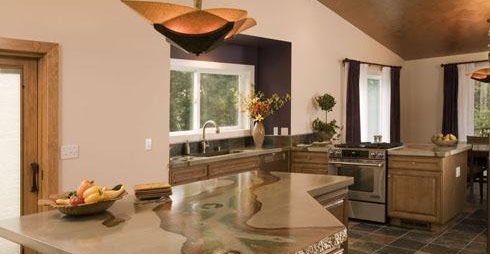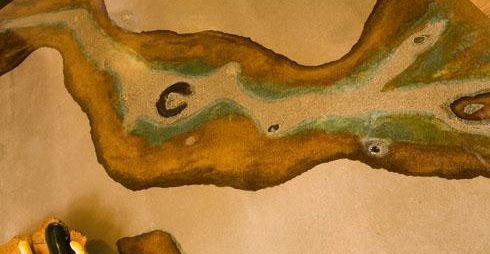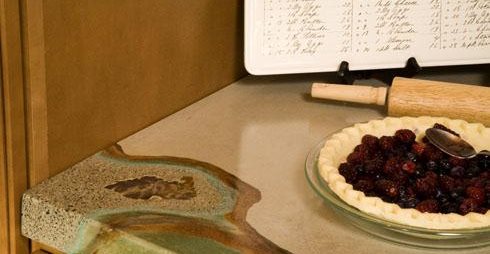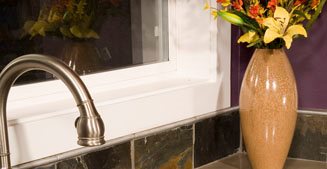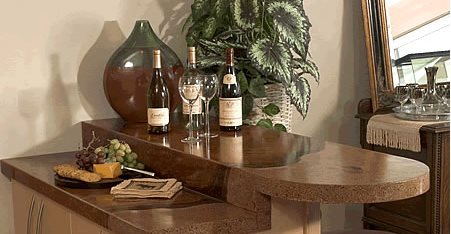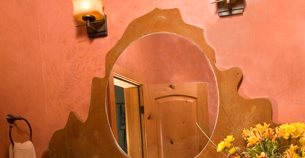Creativity is the secret to the success that Absolute ConcreteWorks (ACW) has had with precast concrete countertops. "It comes down to inspiration," says artist Tommy Cook. "We work with the client to get their vision and then we run with it." This inspirational approach, combined with a solid knowledge of concrete materials and behavior, has led Cook and his partners Steve and Tina Silberman to create some of the more unique countertops around. Tina plays an integral role at ACW, adding the all-important feminine touch. Tina is active with the National Kitchen & Bath Association (NKBA) and applies her eye for style, design and color working directly with interior designers and with ACW's architectural photographer to style photographic sessions of installed ACW work.
Take, for example, the "river runs through it" countertop they recently designed, fabricated, and installed. For the river, Cook positioned stones in the formwork prior to casting with integrally colored concrete. "Since the client wanted the river theme we put numerous stones in the mold, some right off their property and others that they chose from our collection." After the concrete was set and the countertop was flipped over, Cook decided where to grind and polish to get the river bed look and where to apply stains.
"It's all done by hand. There's a lot of brush work and we use different sponges and rollers to create different effects. One of the neat things we sell is that no other product can get that personal-like taking stones directly from the stream on their property and incorporating them into their countertop," says ACW artist Laurie Smith.
ACW has perfected their techniques over several years. The partnership formed when Cook was hired to make countertops for Silberman's new home. This unusual company genesis was described in an earlier Concrete Network story about Absolute ConcreteWork's success. Today, they specialize in concrete countertops, although they also create fireplace surrounds, outdoor kitchens, and other architectural details.
ACW casts their countertops upside down using either a 7-sack, pea gravel mix with their "secret additive" or ACW's SoundCrete™ glass-fiber-reinforced-concrete mix (GFRC). Sinks are often cast integrally into the countertop. "When we are using regular concrete," says Cook, "I need interior and exterior keeper molds to prevent the concrete from flowing away. When it's GFRC it's sprayed on so I only need a mold on one side."
For most countertops, ACW avoids polishing unless it's part of the aesthetic effect. "Concrete mimics the texture of the surface it's poured on," says Cook. "If you pour on glass it will come out looking like glass. We don't actually pour on glass, though, because it creates such a tight matrix on the surface that it doesn't allow our sealers or stains to penetrate properly." ACW uses melamine forms, which provide the surface texture they require. "We use an abrasive pad to take off any excess release agent," says Silberman, "but the only time we polish is if there's a terrazzo finish or if the client wants to expose a little sand."
Cook notes that sealers for concrete countertops have yet to be perfected, although he feels that the manufacturers are now focusing on the issue. "There's no perfect sealer out there. As with marble and granite or other natural surfaces, some are easy to maintain but then stain easily while others are more difficult to maintain but won't stain. But the sealer manufacturers are coming out with better sealers since they are finally realizing that the concrete countertop business isn't going away. They are seeing that if they can come up with something the market is there."
Another recent project that Cook and Silberman take pride in is a two-level bar with an integral cantilevered counter. "We've not seen anyone who's done this as a single piece before," Silberman said. "The client didn't want to bump their knees, so they gave us the challenge of doing it without corbels." By casting as a single piece and strategically embedding steel reinforcing, rather than casting two countertops and a backsplash and tying them together, Silberman had the counterbalanced weight on the lower part to keep the top side from having to have any supports or corbels.
"The comedic element of this," says Silberman, "was when we stripped the forms. You know how when a baby is born the first thing you do is count fingers and toes? That was the look on Tommy's face as we were removing the mold-looking to see if there were any structural issues or cracking problems."
This bar is in the home of a large local concrete producer whose wife had wanted granite. "She said, 'I've got concrete everywhere else in my life, I don't want it in my kitchen, too,'" Silberman laughed. "But she worked with Tommy to come up with the design and now she says she wouldn't hear of anything else."
Then there is ACW's pond sink, which is the perfect fusion of natural art and function. First, the client selects the stump that will support the sink. "Then I let the stump speak to me," says Cook. "I just stare at it until the shape and style of the countertop becomes clear. After I have the countertop molded, then I let the whole thing speak to me to come up with the shape of the sink." He then sculpts the sink from clay to get the flow of the entire piece just right. "I sort of let it sculpt itself."
Absolute ConcreteWorks
Poulsbo-Seattle, WA
360-297-5055
Learn more about concrete countertop embeds
See more concrete kitchen countertops
